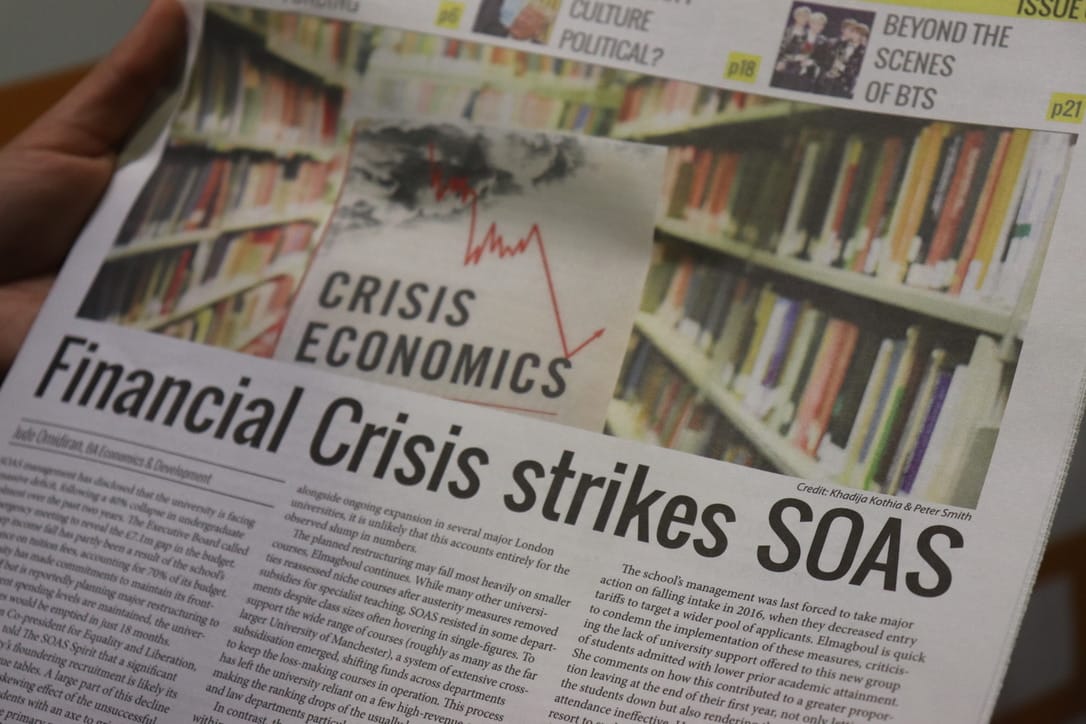Financial Crisis Strikes SOAS

University in financial crisis following crash in undergraduate intake
By: Jude Omidiran, BA Economics & Development
SOAS management has disclosed that the university is facing a massive deficit, following a 40% collapse in undergraduate enrolment over the past two years. The Executive Board called an emergency meeting to reveal the £7.1m gap in the budget. This steep income fall has partly been a result of the school’s over-reliance on tuition fees, accounting for 70% of its budget. The university has made commitments to maintain its front-of-house staff but is reportedly planning major restructuring to survive. If current spending levels are maintained, the university’s cash reserves would be emptied in just 18 months.
Students’ Union Co-president for Equality and Liberation, Youssra Elmagboul, told The SOAS Spirit that a significant factor in the university’s floundering recruitment is likely its sinking position in league tables. A large part of this decline came from the potential skewing effect of the unsuccessful boycott last year, where students with an axe to grind about the strikes may have been the primary participants. Though a SOAS spokesperson stressed that applicants nationwide are falling due to the UK’s overall demographic changes, alongside ongoing expansion in several major London universities, it is unlikely that this accounts entirely for the observed slump in numbers.
Soph Bennett: “It’s all gone to s***”
The planned restructuring may fall most heavily on smaller courses, Elmagboul continues. While many other universities reassessed niche courses after austerity measures removed subsidies for specialist teaching, SOAS resisted in some departments despite class sizes often hovering in single-figures. To support the wide range of courses (roughly as many as the far larger University of Manchester), a system of extensive cross-subsidisation emerged, shifting funds across departments to keep the loss-making courses in operation. This process has left the university reliant on a few high-revenue courses, making the ranking drops of the usually lucrative economics and law departments particularly alarming.
In contrast, the master’s degree intake has remained within predicted levels, offering some breathing room for budgeting. However, this still presents a future hazard; the university will only be receiving funds from this intake for one year, with the possibility of a similar effect occurring among post-graduate applicants, threatening a further sharp drop in income in the following years.
The school’s management was last forced to take major action on falling intake in 2016, when they decreased entry tariffs to target a wider pool of applicants. Elmagboul is quick to condemn the implementation of these measures, criticising the lack of university support offered to this new group of students admitted with lower prior academic attainment. She comments on how this contributed to a greater proportion leaving at the end of their first year, not only letting the students down but also rendering the attempt to boost attendance ineffective. However, she doubts that they would resort to such the strategy easily a second time, adding that they appear to have learnt the value of consistent entry criteria. A spokesperson for the university confirmed this, telling The SOAS Spirit that they wished to “continue to admit only those students who will thrive at SOAS”.
Tuition fees aside, the university is also struggling to engage donor funding. While numbers are healthy, a high proportion of the largest donations are earmarked for specified causes, such as the HEFCE grants for the ongoing Brunei Gallery renovation or the £5m endowment for the Institute of Zoroastrian Studies. Management is often powerless to redirect any of these funds into ailing departments, resulting in a series of attractive new developments using cash that may be more beneficially invested elsewhere.
SOAS is not alone in its financial woes. Earlier in November, three unnamed institutions outside of London were widely reported as being at real risk of bankruptcy, with one already in discussion with insolvency lawyers. Commenting on the cases, Nick Hillman, director of the think tank Higher Education Policy Institute, said that “a university going bust is more likely than at any other point in the last generation” while also raising concerns about the even greater number that are resorting to bridging loans to survive. Co-President Soph Bennett shares Hillman’s views regarding the severity of the situation, saying, “it’s all gone to s***”
In the competitive atmosphere of the increasingly marketised higher education system, the government has issued statements confirming that they would allow universities to crash if they were unable to sustain themselves, though BBC Education Correspondent Sean Coughlan doubts any Education Minister would stand aside without some interventional measures, given the challenging questions of liability for students’ wasted time and fees. A common fear is that even a single bankrupted institution could lead to “contagion” within the sector, as plummeting confidence could create difficulty for universities in finding creditors or attracting valuable overseas students.



